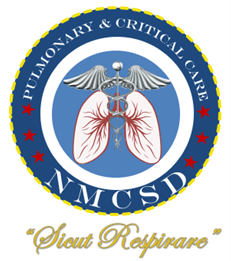The ability to skillfully perform invasive procedures related to Pulmonary and Critical Care Medicine is vital during fellowship training. Fellows are expected to capture an understanding and proficiency in a myriad of invasive and non-invasive procedures. Procedural requirements are divided into three distinct categories:
- Category “A” procedures: These are identified as “core” procedures for which fellows must demonstrate competent and safe independent performance. Prior to graduation, fellows are required to showcase:
- Comprehension of indications, contraindications, risks, and benefits.
- Technical and cognitive proficiency to perform the procedure independently and safely.
- Competency in timely recognition of complications, along with the requisite knowledge to manage potential complications adhering to the standard of care, either independently or through consultation.
- Category “B” procedures: These are “non-core” but essential procedures that fellows should execute competently and safely under supervision. Fellows have opportunities to attain independent competency in these procedures, and independent privileging recommendations are provided on a case-by-case basis. As a graduation requirement, fellows are expected to:
- Understand indications, contraindications, risks, and benefits.
- Possess the technical and cognitive skills to safely perform the procedure with minimal supervision.
- Have knowledge of potential complications, appropriate diagnostic methods to identify complications, and know when to consult for complication management.
- Category “C” procedures: These procedures mandate an understanding and the ability to explain but do not require independent performance by fellows. With infrequent exceptions, independent privileges in these procedures typically necessitate additional training beyond the general fellowship. To graduate, fellows must demonstrate:
- Understanding of indications, contraindications, risks, and benefits.
- Basic knowledge about the procedure techniques, expected outcomes, and complications.
The “Category A” procedures encompass the following:
- Diagnostic flexible bronchoscopy, which involves:
- Introduction of bronchoscope via mouth, nose, and airway devices.
- Implementation of proper topical anesthetic delivery techniques.
- Recognition of “standard” and “irregular” endoscopic findings during inspection bronchoscopy.
- Fluoroscopy-assisted biopsy
- Performing endobronchial biopsy
- Administering endobronchial and transbronchial brushing
- Conducting bronchoalveolar lavage
- Execution of trans-bronchial needle aspiration
- Implementation of trans-bronchial lung biopsy
- Basic pleural procedures include:
- Performance and interpretation of pleural ultrasound
- Ultrasound-guided thoracentesis
- Tube thoracostomy
- Handling of pneumothorax with needle/catheter drainage systems
- Airway and respiratory procedures, which incorporate:
- Establishing and maintaining an open airway in non-intubated, unconscious, paralyzed patients
- Oral and nasotracheal intubation*
- Bronchoscopic intubation*
- Ventilation through bag or mask
- Mechanical ventilation using pressure, volume, time, and flow-cycled mechanical ventilators
- Use of reservoir masks, CPAP masks for additional oxygen delivery, humidifiers, nebulizers, and incentive spirometry
- Weaning and application of respiratory care techniques
- Insertion of endobronchial blockers*
- Evaluation and management of circulation involving:
- Arterial puncture and blood sampling
- Insertion of arterial, and central venous catheters
- Operation, calibration, and interpretation of the ICU’s hemodynamic recording systems, which include arterial catheters, central venous catheters, pulmonary artery catheters, and intracranial pressure monitors.
- Interpretation of PA catheter waveforms.
- Basic and Advanced Cardiac Life Support
- Emergency Cardioversion
- POCUS Ultrasound assessment
- Titration of vasoactive agents.
- Conducting pulmonary function tests, such as:
- Spirometry
- Bronchoprovocation studies (methacholine and exercise)
- Lung volume determination
- Diffusing capacity evaluation
- Arterial blood gas analysis
- Functional laryngoscopy
- Cardiopulmonary exercise studies
- Conscious sedation management during invasive procedures.
Category “B” procedures encompass the following:
- Advanced Flexible Bronchoscopy, which includes:
- Linear Endobronchial Ultrasound (EBUS)
- Radial Endobronchial Ultrasound (EBUS)
- Navigational Bronchoscopy
- Bronchoscopic Cryoextraction
- Emergent Airway Balloon Dilatation
- Advanced Pleural Procedures, such as:
- Insertion and Management of Tunneled Indwelling Pleural Catheters
- Medical Thoracoscopy (Pleuroscopy)
- Ultrasound-Guided Transthoracic Needle Biopsy
- Airway and Respiratory Procedures, including:
- Percutaneous Tracheostomy
- Circulation Management, which includes:
- Management of ECMO
- Management of Balloon Pumps and Other Mechanical Assist Devices
- Interpretation of PA Catheters
- Management of CRRT
- Sleep Medicine, such as:
- HST Interpretation
- Basic CPAP Initiation and Titration
Category “C” procedures encompass the following:
- Advanced Diagnostic Bronchoscopy, which includes:
- Robotic Bronchoscopy
- EUS-B (Esophageal Introduction and Sampling with EBUS Bronchoscope)
- Therapeutic Bronchoscopy, including:
- Rigid Bronchoscopy
- Central Airway Debulking
- Use of Endobronchial Ablative Therapies (Laser, APC, Snare, etc.)
- Cryobiopsy
- Airway Stent Insertion and Removal (including T-Tubes)
- Endobronchial Valve Insertion
- Photodynamic Therapy
- Mucosal Injection of Medications (Steroids, Chemotherapy)
- Non-Emergent Airway Dilatation
- Airway and Respiratory Procedures, such as:
- Surgical Tracheostomy
- Circulation Management, which includes:
- ECMO Cannulation
- Insertion of Mechanical Assist Devices
- Hemodialysis Management
- Sleep Medicine, including:
- Polysomnogram Interpretation
- MSLT/MWT Interpretation
- Treatment of Narcolepsy
- Initiation and Titration of Advanced Devices for Management of Sleep Disordered Breathing (AVAPS, ASV, BiPAP AVAPS, etc.)
- Other Procedures, such as:
- PEG Tube Insertion
- Pericardiocentesis
- Vasodilator Studies for Diagnosis of Pulmonary Hypertension
